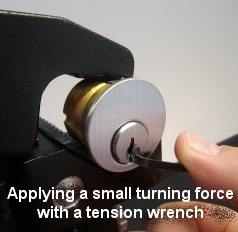 What’s the most common mistake made by beginners? Too Much Tension.
What’s the most common mistake made by beginners? Too Much Tension.
I’m not sure how the word “tension” made it into the lock picker’s lexicon but tension is the lock picker’s word for torque or turning force. When picking a lock, you apply torque, or tension, to the lock cylinder while you’re using the picks to lift the pins. You can learn more about how to pick locks in our Illustrated Guide to Picking Locks here.
If you haven’t had much experience successfully picking locks, you might be surprised how little tension is the right amount. If you’re not sure how much tension is the right amount, the answer is probably: less than you’re using.
It barely takes any tension at all to turn a lock that is already picked. Think about the amount of turning force required to turn your lock with the key. Almost none. Tension for picking a lock is barely more than this.
The problem with tension that is too heavy handed is that pins can be bound at the wrong height. Pins will become pinched between the plug and lock housing won’t drop back down once lifted with your picks. The lock will feel as if the pins are all set at the shear line when they aren’t. Other pins won’t be able to become set at the shear line because these bound pins are preventing plug rotation.
In fact, many experienced pickers like to vary their tension if they reach a point where progress seems to have stopped. They will briefly switch from light tension to almost none to allow any pins that are pinched to drop out of the way.
